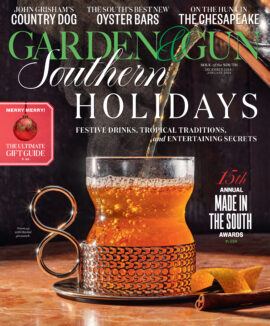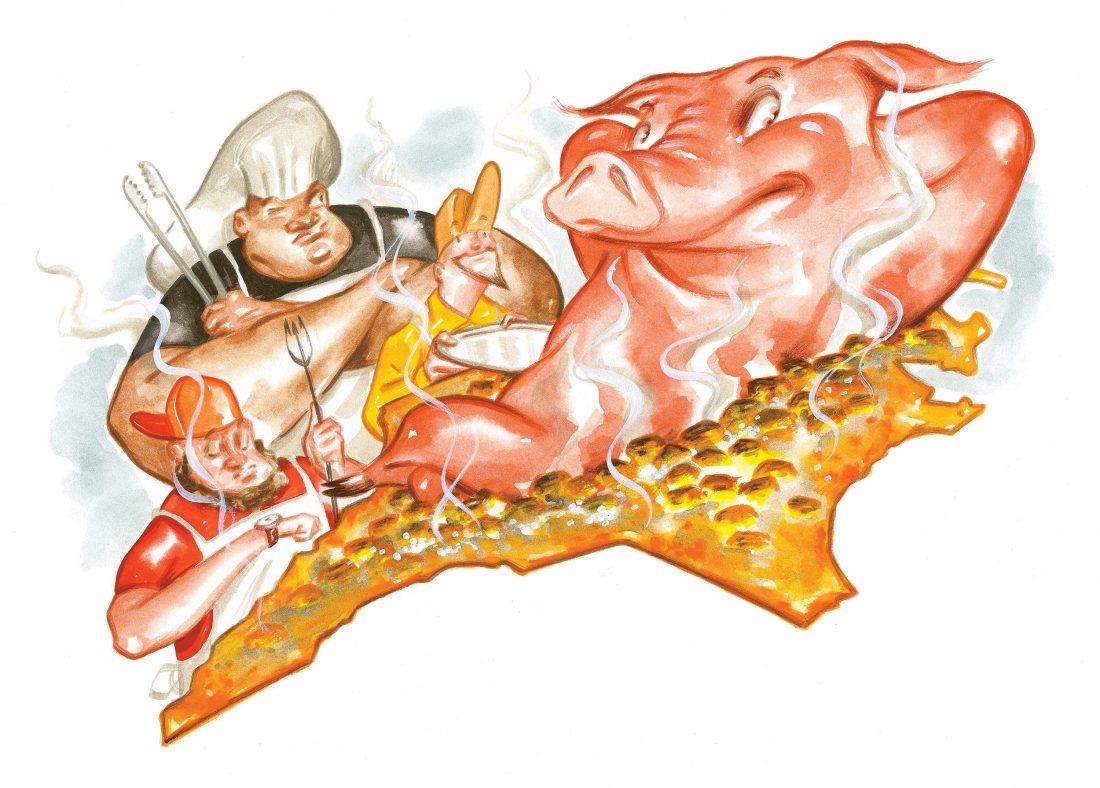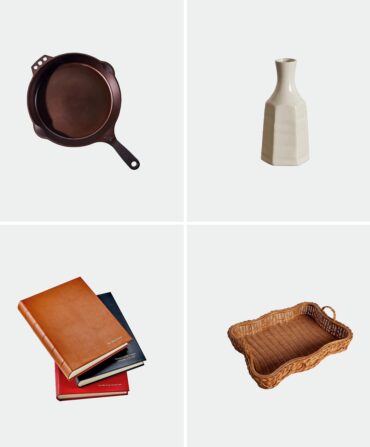-
North Carolina: A Real Pig Deal
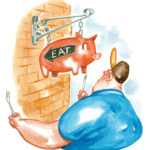
Illustration: Tim Bower
Bahama, North Carolina
Some of the best pit masters in the Tar Heel State will be on hand at the inaugural NC Barbecue Revival, a three-day-long barbecue fantasy camp held on Green Button Farm in Bahama, to help you brush up on wood selection, whole-hog breakdown, sauce preferences, or any other ’cue concerns. Splurge for a ticket package or reserve space at individual events—many of which are capped at only fifteen or thirty attendees. “More than anything, we want to create a sense of intimacy,” says Wyatt Dickson, one of the organizers as well as the head barbecue man at Picnic in Durham. The events’ smaller size means you’ll have a wealth of opportunities to spend time with the pros. Up first is the opening-night dinner, a sort of pit-master mixer, where you’re welcome to pull up a chair next to the likes of Sam Jones, from the Skylight Inn in Ayden. You can also spend a few late-night hours helping Elliott Moss of Asheville’s Buxton Hall Barbecue tend the pits. Or join Phoebe Lawless of Scratch, in Durham, for a class on baking with lard. And Green Button farmer Ryan Butler will oversee a hands-on whole-hog-butchery seminar. “Where I grew up, in Fayetteville, we didn’t have a big, famous barbecue joint,” Dickson says. “We went to pig pickings in people’s backyards. I want to get us back to that kind of barbecue.” If he keeps this up, he just might teach himself out of a job. —ncbbqrevival.com
-
Alabama
Heirloom Variety
Wander through Birmingham Botanical Gardens’ sixty-seven acres this fall and you’ll see such Southern standards as crimson Japanese maples, showy camellias, and banks of the autumn-blooming Encore azaleas that were developed in Alabama and Louisiana. But step indoors and you’ll find riches of a different sort at Antiques at the Gardens (October 7–9), where dealers will set out spreads of eighteenth-century French provincial furniture, framed Audubon prints, sterling tea sets, garden urns cast from Italian originals, and much more. Southern landscape professionals, architects, and interior designers will show off their skills in curated rooms throughout the neoclassical Garden Center. Crib style secrets from design experts, including Texas native Mark D. Sikes, who worked with Reese Witherspoon on her Draper James store in Nashville and recently released the coffee-table book Beautiful: All-American Decorating and Timeless Style. Sikes’s advice for budding decorators: “Give life and age to a room. Whether it’s a chair, a credenza, or a writing table, every room should have a fabulous antique.” We know just the place to start looking. —bbgardens.org
-
Arkansas
Second Act
When the Robinson Center in Little Rock opened in 1939, experts considered it the most technologically advanced theater of its time. Most notably, it was the only auditorium in the South with air-conditioning. For seven decades, the center hosted everyone from Ella Fitzgerald to Willie Nelson; Elvis Presley made his first recording of “Hound Dog” there in 1956. “Anybody who has lived in central Arkansas for any amount of time has a personal story connected to that building,” says Gretchen Hall, president of the Little Rock Convention and Visitors Bureau. “They graduated from high school on that stage, went to cotillion in the basement, or saw their first concert there.” Gradually, the building started showing its age and no longer attracted big-name shows. But in 2014, the historic venue began a two-year intermission to undergo a $70 million face-lift. This November, the curtain rises on a (once again) state-of-the-art facility. “The most dramatic change is in the performance hall, where we took the stage and the orchestra level and dropped them thirty-six feet,” Hall says. “That pulled every seat in the house closer for a better view.” So no matter what your row assignment, you’ll feel like a VIP. —robinsoncentersecondact.com
-
Florida
Fish Tales
According to Islamorada lore, once when Barbara Bush joined her husband, George, for one of his many trips to Cheeca Lodge, her guide accidentally ran the boat aground. Unfazed, the first lady jumped into the water to help dislodge the skiff, and then kept right on fishing. No word on whether she hooked any of the snook, mahimahi, or billfish that have earned these waters the title of Sportfishing Capital of the World. Situated on Upper Matecumbe Key’s eastern shore, Cheeca opened in 1946 and has lured such discerning anglers as Paul Newman and Edward R. Murrow. “We describe our style as ‘barefoot elegance,’” says the lodge’s general manager, Bob LaCasse. “We’re flip-flop friendly.” This year, the upscale fish camp—complete with beachfront bungalows, a spa, and a golf course designed by another frequent guest, Jack Nicklaus—marks its seventieth anniversary with a slew of events and one not-to-miss fishing competition, the All-American Backcountry Tournament (November 10–12). Days later, enjoy Cheeca’s Anniversary Celebration (November 16), when guests gather for a seafood dinner plus a sneak peek at the renovated rooms slated for bookings in spring 2017, just in time for the water—and the fishing—to heat up. —cheeca.com
-
Georgia
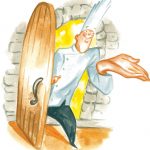
Illustration: Tim Bower
A Masked Ball
Last year, the Beverly Hillbillies piled into a Model T, and Santa Claus hitched a ride in the back of an old pickup. A raucous crowd of zombies, skeletons, pirates, and princesses of all ages fell in behind them as they moved through downtown Athens as part of the Wild Rumpus Parade & Spectacle (October 29). The annual costumed procession, which takes its inspiration from Maurice Sendak’s children’s classic Where the Wild Things Are, began in 2009 as a small affair but now sees upwards of four thousand revelers. “It’s like I just grabbed a megaphone and said, ‘Line up. Let’s go,’” says Timi Conley, the organizer. The parade is no college rager; it’s wholesome, freak-flag-flying fun. Take the kids to the pre-parade Monster Mash, and then tip the babysitter extra for late-night duty and hit the after party, featuring soul singer Charles Bradley, at the Georgia Theatre. —wildrumpus.org
-
Kentucky
Best In Show
First of all, if you happen to find yourself among the world’s top horse buyers and breeders during Keeneland’s prestigious November Breeding Stock Sale: congratulations. Second, be sure to take a break from the sales pavilion to do a lap through the hallways circling the arena, where you’ll find some of the world’s rarest equestrian art on display, days before it’s sold to the highest bidders at the Sporting Art Auction (November 21) in Lexington. “Anyone in the Thoroughbred business comes to Keeneland to buy their horses,” says Cross Gate Gallery owner and auction organizer Greg Ladd. “So we figure it’s good business to hang our inventory in front of people who already love horses.” The rest of us can browse the impressive collection, too, and place bids via the gallery’s website or over the phone. Among the 175 lots up for grabs is a William Orpen portrait of Sergeant Murphy, the first American-owned horse to win the English Grand National, the world’s most difficult steeplechase. Bidding on the Orpen is expected to exceed $350,000, but plenty of sculptures and paintings will come in well below that mark—and looking is free. —thesportingartauction.com
-
Louisiana
Take Note
It’s only fitting that the city that birthed jazz is leading a new form of musical art—this time, in the realm of architecture. New Orleans Airlift, a collective of Crescent City artists, built the first Music Box concert venue in 2011, refashioning the remains of a blighted Creole cottage in the Bywater neighborhood into a group of ramshackle buildings that doubled as musical instruments. In one structure, a stethoscope broadcast visitors’ heartbeats through a belfry. In another, an organ piped its sound through plumbing. Since then, the group has created other temporary installations around the city and beyond, attracting such performers as Wilco, Solange Knowles, and Preservation Hall Jazz Band. Now the Music Box is going from pop-up to permanent. Last spring, Airlift purchased a 55,000-square-foot section of Bywater land and an adjoining warehouse. The property will serve as the long-term home for the group’s quirky collection of music-making shacks, shanties, and phone booths—now called the Music Box Village. The housewarming party? A fall concert series that includes a Caribbean American jam session with L’Union Creole and a performance conducted by the local one-man-band Quintron. “In New Orleans, you’re surrounded by legendary artists everywhere you turn,” says the project’s cofounder Jay Pennington. “Music Box is an homage that borders on both fine art and roadside attraction.” —neworleansairlift.org
-
Maryland
High Horse
Sometimes it pays to think small. It did for the late sportscaster Jim McKay, who after attending the first Breeders’ Cup—an annual series of Grade I Thoroughbred races that honor breeders nationwide—decided to host a similar event dedicated exclusively to Maryland’s equine heritage. He got the word out to Old Line State breeders and threw the first Maryland Million Day in 1986. “Maryland grows horses like other states grow corn,” says Cricket Goodall, the event’s executive director. On October 22 at Laurel Park racetrack (located halfway between Baltimore and D.C.), equestrian lovers will gather to watch Maryland-sired steeds compete in turf races for purses totaling $1 million. Stay for in-between entertainment such as Jack Russell terrier sprints, Clydesdale demonstrations, and pony races with pint-size child jockeys. McKay’s modest affair grew exponentially over the last thirty years, and today, the Maryland Million is one of the state’s biggest parties. “There are similar events in New York, Florida, and twenty other states,” Goodall says. “But Maryland was the first.” —marylandmillion.com
-
Mississippi
As I Lay Dying
The distinction between ninety degrees and eighty degrees might not seem like all that much, but in the South we call it fall, meaning it’s again safe to venture outside for events like the Harvest Supper (September 22) in Oxford, without fear of perspiring through your party duds. The annual fund-raiser and field feast, benefiting the University Museum and Historic Houses, is held on the lawn at Rowan Oak, William Faulkner’s antebellum mansion turned museum. This year, under lights strung from towering oaks and cedars, guests will dine on whole-hog barbecue from Oxford’s own John Currence and all the fixings prepared by chef Elizabeth Heiskell of nearby Woodson Ridge Farms, a spot Faulkner called “grand country.” The University Steel Orchestra and, later, folksy singer-songwriter Shannon McNally will provide the music. “It’s a great mix of people—artists and writers, local donors and people from out of town,” says the Friends of the University Museum president Carlyle Wolfe. “This is not an event where you reserve a table for your party. It’s very much about mingling and meeting people you don’t know.” —museum.olemiss.edu
-
Oklahoma
Herd Mentality
It’s one thing to buy a pair of chickens, a pig, a goat, or even a cow. But a buffalo? No, really. Anyone looking to seriously upsize their livestock collection is invited to place a bid at the Wichita Mountains Wildlife Refuge’s annual American Bison Auction (October 20). You don’t even need a big backyard, says biologist Dan McDonald, though in that case you’ll need a substantial freezer. “We get folks who want a bunch of animals for a ranch,” he says, “but we also get locals who just want one or two to take straight to the butcher.” That’s been a constant since 1970, when the refuge held its first auction. The herd’s ancestors were just fifteen bison from what is now the Bronx Zoo, sent to repopulate the West at a time when the species was nearly extinct. Now, though, the landscape can’t handle their numbers. McDonald and his crew depend on the auction to maintain the herd’s population size—each year they sell more than 125—and raise money for the refuge. So there’s no need to feel guilty about taking advantage of the rare opportunity—just be prepared to pay for it. “The last few years, the animals have been very expensive,” due to increased demand, McDonald says. “In the past, you could get a bison for three hundred dollars. Last year, it was more like two thousand bucks.” —fws.gov/refuge/Wichita_Mountains
-
South Carolina

Illustration: Tim Bower
Literary Legacy
Even when the late writer Pat Conroy saw a line snaking out the door at one of his book signings, he’d still make time to listen to the stories of each and every fan and aspiring author. After his funeral in March, his wife, his agent, and the mayor of his beloved hometown of Beaufort began discussing ways to honor that generosity. A plaque? A larger-than-life sculpture? “Pat was not a statue guy,” says his wife, the author Cassandra King. “He was an action guy.” In that spirit, the group conceived the idea for the Pat Conroy Literary Center, which opens in October in a renovated antebellum home on Charles Street. King will serve as interim executive director, and the honorary board includes Conroy’s friends John Grisham and Barbra Streisand. The space will welcome guests with an open house and an exhibit of Conroy’s personal papers during the Pat Conroy Literary Festival (October 20–23). And in early 2017, the center will begin rolling out a regular series of readings, lectures, book groups, and writing workshops. “We don’t have Pat with us anymore,” King says, “but we can pick up the generosity of spirit that he had toward other writers and run with it.” —patconroyliterarycenter.org
-
Tennessee
A Storied Gathering
“I wanted to go squirrel hunting when I was sixteen,” recounts the Appalachian author, NPR contributor, and internationally known storyteller Donald Davis. “My dad made me skin the squirrels, and my mother cooked them for supper. From then on, I was a great hunter of grocery stores.” To hear the full account and other anecdotes from Davis’s new book, Cripple Joe: Stories from My Daddy, you’ll need to head to this year’s National Storytelling Festival (October 7–9), in Jonesborough. More than two dozen skilled raconteurs and thousands of rapt listeners converge on the historic hamlet—Tennessee’s first town—for a weekend filled with stories that are alternately true, stretched, sad, outlandish, uproarious, and sometimes just plain odd. The event has come a long way since the first celebration, when hay bales and wagons served as stages, but forty-four years later, the festival retains its small-town charm. Take a tip from Davis to make the most of your weekend: “You can try to chase the people you want to hear, which is extremely hard to do,” he says. “Or you can pick one spot and settle there for the day.” Come nightfall, though, spread a blanket near the gazebo along Little Limestone Creek and get ready for the ghost story series. Goose bumps guaranteed. —storytellingcenter.net/festival
-
Texas
Lone Star Luminance
Even the art is bigger in Texas. The latest exhibition to open at the Chinati Foundation in Marfa is a 10,000-square-foot building, seventeen years in the making, designed by the octogenarian master of light and shadow Robert Irwin. “It was pretty extraordinary to watch an artist work a construction site like a studio, moving walls with bulldozers and cranes,” says the foundation’s director, Jenny Moore. It’s the sort of large-scale creation the New York–trained sculptor Donald Judd envisioned when he came to Marfa in the 1970s with the goal of setting aside land where artists would have room to build permanent installations under the bright, sprawling sky. Irwin’s massive project—a stark concrete building that trades canvases for the pattern play of natural light on its walls—is on view by guided tour only except during the annual Chinati Weekend (October 7–9), the lone time the foundation’s thirty-four buildings are completely open to the public. It’s well worth the trip, but you might want to stock up on good podcasts for the long, flat drive—Marfa is three hours from the closest airport. —chinati.org
-
Virginia
Many Thanks
If you thought America’s first Thanksgiving was hosted by the pilgrims at the Plymouth Colony, a Virginian will be happy to set you straight. The story goes something like this: A year before the Mayflower set sail, Captain John Woodlief of Bristol, England, crossed the Atlantic to establish the Berkeley Settlement, near present-day Charles City, in 1619. After landing in Virginia, Woodlief and thirty-five settlers held the first of three annual Thanksgiving celebrations. But after a 1622 Powhatan attack decimated the fledgling community, the story of the first American Thanksgiving vanished. The account was rediscovered in the archives of the New York Public Library in 1931, and for the past few decades, Woodlief’s descendants have been fighting to make sure he gets his rightful due in the history books. Now there’s an annual autumn get-together at the modern-day Berkeley Plantation. The Virginia Thanksgiving Festival (November 6) includes a reenactment of the Woodlief landing on the very same hundred-yard stretch of the James River, as well as demonstrations of colonial arts such as blacksmithing, doll making, and quilting. Oh, and loads of turkey—one Thanksgiving tradition these Virginians are willing to share with the Johnny-come-latelies in Massachusetts. —virginiathanksgivingfestival.com
-
Washington, D.C.
Party Lines
Most Southern cities with any food scene to speak of have a restaurant week. But if a Bloody Mary piled high with all the extravagant fixings—celery, pickled okra, spicy green beans, bacon, and shrimp—is more your idea of a meal, head to our nation’s capital for D.C. Cocktail Week (November 14–20). It might be the only time all year that you can score a cocktail and a paired snack for less than $15 in the city’s increasingly tony dining landscape—meaning that you can knock off several bucket-list bars without breaking the bank. Think agave mules and smoked fish at José Andrés’s Oyamel, or a rum concoction alongside a bite-sized steak sandwich at Bar Dupont. This year’s lineup will include more than fifty establishments. Just make sure your Uber rating is high— designated drivers will be in demand. —dccocktailweek.com
-
West Virginia
Rail To Trail
Brilliant fall color splashed across mountainsides stuns from any vantage point. But it looks especially fine from a comfy seat on the New River Train as it winds through the “Grand Canyon of the East” for the fiftieth year in a row. Four dates—October 15, 16, 22, and 23—allow nearly five thousand guests in all to ride on the country’s longest excursion passenger train made up of vintage railcars. The route begins in Huntington and follows the former Chesapeake & Ohio main line through downtown Charleston before winding alongside the sixty-five-mile New River Gorge. You’ll reach the turnaround point at lunchtime, when the train pulls into the Hinton station. On the return trip, keep an eye out for wildlife, says Joe Rosenthal of the Collis P. Huntington Railroad Historical Society. “We see bears and plenty of deer,” he says. “Sometimes we even spot eagles.” —newrivertrain.com

